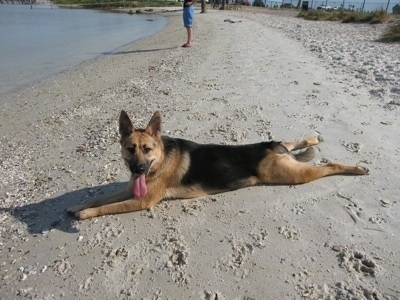I've recently had several families with children approach me with questions about kids and dogs, and how to keep their children from getting bitten by the family dog.
So, I figured it was time to pool all of my information and write about this oh-so-important topic!
So, I figured it was time to pool all of my information and write about this oh-so-important topic!
The FACTS: Kids don't have good boundaries, and they also don't read dog body language signals...which is why they get bit.
The Language Barrier: The number one problem in dog/human interactions in a lack of understanding.
Usually by the time I hear from parents of small kids that there is a problem, the dog has been saying very politely (but very clearly) for a long time, "I am uncomfortable about this child."
But the kids don't see it (and often the adults don't, either). So the dog has to 'raise his voice.'
By the time we have growling, snapping, or barking, the dog has usually given 100 or more small canine body signals about how stressed he is. And he may have been giving those signs for a long time - weeks, months, or years. But if we've missed the signals, it's not the dog's fault, right?
First off, more adults and kids need to learn to read canine body language, so we can intervene in stressful child to dog interactions long before the dog feels the need to bite.
By the time we have growling, snapping, or barking, the dog has usually given 100 or more small canine body signals about how stressed he is. And he may have been giving those signs for a long time - weeks, months, or years. But if we've missed the signals, it's not the dog's fault, right?
First off, more adults and kids need to learn to read canine body language, so we can intervene in stressful child to dog interactions long before the dog feels the need to bite.
Here are two awesome body language videos we regularly recommend at Front Range K9 Academy. They are just the tip of the iceberg in regards to the amount of good information you can find on the internet about canine body language. We invite you to explore the vast internet resources about dog body language even more, but these will get you started:
.jpg) RIGHT & WRONG: The next step is teaching kids how they should - and should NOT- interact with pets is imperative.
RIGHT & WRONG: The next step is teaching kids how they should - and should NOT- interact with pets is imperative. Some things should be obvious - no yanking of tails, poking of eyes, pulling of fur, etc. But other things are more subtle - like teaching toddlers to 'let sleeping dogs lie.'
These two posters from the late Dr. Sophia Yin are perfect for most families to explore together:
But parents, beware! Simply telling a child under the age of about 5 to 7 years old these things is not really going to help the situation.
Before the child has developed the appropriate neurological links that lead to consequential learning skills, they are not able to process this information enough for it to affect their behavior. Even when children can parrot back that they should 'be nice to doggy,' it doesn't always mean they understand what they are saying.
Before the child has developed the appropriate neurological links that lead to consequential learning skills, they are not able to process this information enough for it to affect their behavior. Even when children can parrot back that they should 'be nice to doggy,' it doesn't always mean they understand what they are saying.
So, it is still up to the parents to keep both the dog and the child safe.
My rule to new parents (or anyone with kids under 15 around) is that during any time dogs and kids are together, one adult must be in charge of watching dog-kid interactions 100% of the time.
That means that you can't watch the dog and the kids and cook dinner, and watch a movie, and respond to emails, and talk on the phone, and..... The person in charge of the dog has ONLY that job.
I know. I know.... But you're busy! Or you want to relax and enjoy the family! You can't watch the dog and the child 24/7, right?
Sometimes in today's busy world we really do need to be multi-tasking. So, I also recommend giving the dog a space that is truly 100% off limits to the child.
Get creative! You can use simple barriers like these small, adjustable pet pens, to section off areas in rooms so that the dog is not banished to a crate, etc. and is still part of the family, but is protected. Make training to go to a bed in his 'special space' fun for the dog - providing lots of chew toys, treats, and attention to him while he is there.
Get creative! You can use simple barriers like these small, adjustable pet pens, to section off areas in rooms so that the dog is not banished to a crate, etc. and is still part of the family, but is protected. Make training to go to a bed in his 'special space' fun for the dog - providing lots of chew toys, treats, and attention to him while he is there.
BUT, the supervision rule still applies, even with a dog in his 'special, off-limits' spot. If there isn't an adult able to supervise the child to make sure he's not breaking through the boundaries or barriers - then the dog must be kenneled. This includes dinner prep, quick trips to the bathroom, catnaps, etc.
Our job as adults is to protect our child AND our dog. While this may seem extreme, the alternative - which involves direct and present danger to both the dog and the child - are unthinkable.
Another great resource for parents with pooches is Barbara Shumannfang's book: Happy Kids, Happy Dogs. It's loaded with great training tips and ideas on getting through parenthood with dogs - from infants to teens!
That's it from this end of the leash.
Jennifer Hime is a dog trainer and behaviorist, the owner of Front Range K9 Academy in Wheat Ridge, CO.

























